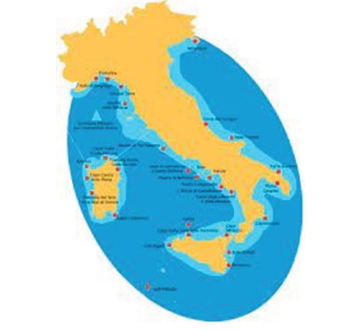- Submissions

Full Text
Examines in Marine Biology & Oceanography
Marine Protected Areas as Paper Parks in Italian Seawaters
Nicola Cantasano*
National Research Council, Institute for Agricultural and Forest Systems in the Mediterranean, Rende Research Unit, Italy
*Corresponding author: Nicola Cantasano, National Research Council, Institute for Agricultural and Forest Systems in the Mediterranean, Rende Research Unit, Rende, Cs., Italy
Submission: August 21, 2023;Published: August 24, 2023

ISSN 2578-031X Volume6 Issue2
Opinion
Marine Protected Areas (hereafter MPAs) could be the main cornerstones in the protection of Italian coastal waters. Really, Italy holds a rich marine biodiversity confirmed by the presence of 32 MPAs for a global surface area of 228.000 hectares, as the 4.53% of Italian territorial seawaters (Figure 1).
Figure 1:Geographic map of MPAs in Italian coastal seawaters (drawn from internet at: https://www.marevivo.it/attivita/aree-marine-protette).

These numerical data seem quite good but, really, they are very far from the threshold level of 30% recommended by the International Union for Conservation of Nature (IUCN), that should be protected in European coastal waters by 2030 [1]. In Italian seaboard areas, MPAs are until now simple paper parks without any running operations and, very often, lacking in management plans, as stated by the World Wildlife Fund [2]. Actually, it is very difficult to solve this critical issue because MPAs form a complex socio-ecological system that needs a multiple and holistic approach, hard to apply in a country characterized by a high fragmentation between local, regional and national authorities. Moreover, there are many problems concerning the establishment and the effectiveness of MPAs such as: incorrect territorial planning, lacking governance, absence of controls, inadequate financial support and conflicts amongst potential stakeholders [3]. Above all, the ineffectiveness of MPAs is due to a little and short involvement of local people in their management, that instead should be the base of a bottom-up process [4]. In fact, it is necessary to have a strong support from the public opinion in the design and in the implementation of MPAs [5] because human dimension plays an important role for their complete and successful outcome [6]. In this way, it is timely to promote an effective human engagement in the management of MPAs locating them in coastal areas characterized by high population density and enclosed with land-based parks, associated to human amenities [7]. In fact, ensuring an effective protection both in land and sea environments could improve the functional role of MPAs preventing marine pollution, sedimentation and/or eutrophication processes [8].
In the long run, the presence of MPAs could also increase the fishery productivity through spillover effects just outside the protected areas [9,10]. Finally, MPAs could enhance other benefits such as: Cultural activities, recreation, tourism, education and scientific research [11-16]. In conclusion, an effective human engagement in the establishment and in the implementation of MPAs could become the key-word to coordinate public and private efforts in a sound coastal management..
References
- IUCN (2022) Protected areas and land use.
- WWF (2017) Preventing paper parks: How to make the EU nature laws work.
- Pieraccini M, Coppa S, Lucia GA (2017) Beyond marine paper parks? Regulation theory to assess and address environmental non-compliance. Aquatic Conservation: Marine and Freshwater Ecosystems 27(1): 177-196.
- Ferse SCA, Costa MM, Máñezv KS, Adhuer DS, Glaser M (2010) Allies, not aliens: Increasing the role of communities in marine protected area implementation. Environmental Conservation 37(1): 23-34.
- IUCN (2021) Ocean and coasts. IUCN works to conserve coastal, marine and polar ecosystems, and the many benefits they provide for humanity.
- Bruner AG, Gullison RE, Blamford A (2004) Financial costs and shortfalls of managing and expanding protected-area systems in developing countries. BioScience 54(12): 1119-1126.
- Free CM, Smith JG, Lopazanski CJ, Brun J, Francis TB, et al. (2023) If you build it, they will come: Coastal amenities facilitate human engagement in marine protected areas. People and Nature, pp. 1-18.
- Cicin-Sain B, Belfiore S (2010) Linking marine protected areas to integrated coastal and ocean management: A review of theory and practice. Ocean & Coastal Management 48(11): 847-868.
- Lorenzo M, Guidetti P, Franco A, Calò A, Claudet J (2020) Assessing spillover from protected areas and its drivers: A meta-analytical approach. Fish and Fisheries 21(5): 906-915.
- Marshall DJ, Gaines S, Warner R, Barneche DR, Bode M (2019) Underestimating the benefits of marine protected areas for the replenishment of fished populations. Frontiers in Ecology and the Environment 17(7): 407-413.
- Roncin N, Alban F, Charbonnel E, Crechriou R, Modino RC, et al. (2008) Uses of ecosystem services provided by MPAs: How much do they impact the local economy? A southern Europe perspective. Journal for Nature Conservation 16(4): 256-270.
- Angulo-Valdès JA, Hatcher BG (2010) A new typology of benefits derived from marine protected areas. Marine Policy 34(3): 635-644.
- Ban NC, Gurney GG, Marshall NA, Whitney CK, Mills M, et al. (2019) Well-being outcomes of marine protected areas. Nature Sustainability 2(6): 524-532.
- Erskine E, Baillie R, Lusseau D (2021) Marine protected areas provide more cultural ecosystem services than other adjacent coastal areas. One Earth 4(8): 1175-1185.
- Grorud-Calvert K, Sullivan-Stack J, Roberts C, Constant V, Pike EP, et al. (2021) The MPA guide: A framework to achieve global goals for the ocean. Science 373(6560): 1-11.
- Marcos C, Diaz D, Fietz K, Forcada A, Ford A, et al. (2021) Reviewing the ecosystem services, societal goods and benefits of marine protected areas. Frontiers in Marine Science 8: 1-37.
© 2023 Nicola Cantasano. This is an open access article distributed under the terms of the Creative Commons Attribution License , which permits unrestricted use, distribution, and build upon your work non-commercially.
 a Creative Commons Attribution 4.0 International License. Based on a work at www.crimsonpublishers.com.
Best viewed in
a Creative Commons Attribution 4.0 International License. Based on a work at www.crimsonpublishers.com.
Best viewed in 







.jpg)






























 Editorial Board Registrations
Editorial Board Registrations Submit your Article
Submit your Article Refer a Friend
Refer a Friend Advertise With Us
Advertise With Us
.jpg)






.jpg)














.bmp)
.jpg)
.png)
.jpg)










.jpg)






.png)

.png)



.png)






